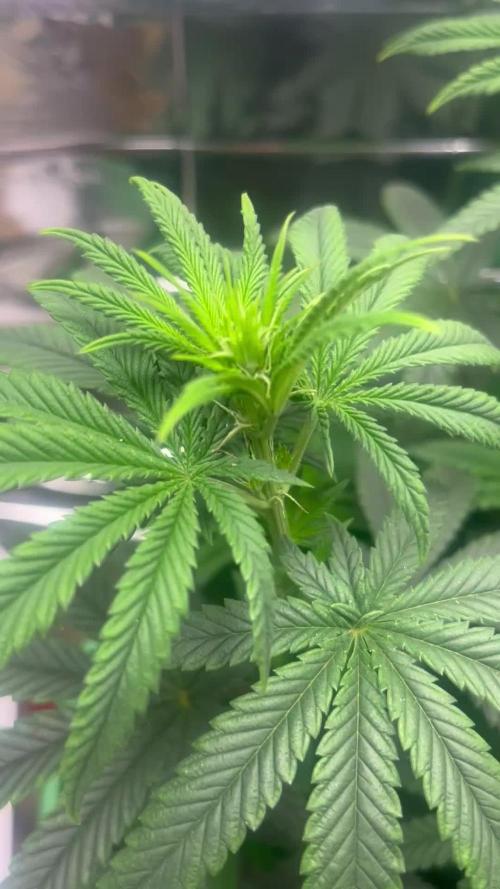The Grow Awards 2026 🏆 



































Likes
Comments
Share


@LegacyMarketFarm
Follow
APRIL 18TH 2024 - The 3rd batch of clones was taken yesterday and mother plants stripped back aggressively now that focus will be going toward the beds and clones. The generation 2 mom's are going to be vegged up and ready to produce our second harvest's set of clones. We have taken 3 batches of clones kept them in half gallon bags in each of the beds so we can pick the absolute best of each to transplant into the beds & proceed into the grow with. Next update will be of each individual diary! We got @Seedsman Purple Ghost Candy in this cycle by splitting the Exotic Animal bed half Purple Ghost Candy !
On the Kitty cat front, Barns finally got the courage to approach us over a few days, Maybe a week. We where finally able to pick her up and bring her inside, She has been a happy new member of the family ever since, Making that another successful rescue animal adopted from outside.
FOLLOW US ON X for EXCLUSIVE UPDATES : https://twitter.com/LegacyMrketFarm
MAKE SURE TO CHECK OUT OUR YOUTUBE CHANNEL FOR IN DEPTH TUTORIALS : https://www.youtube.com/@LegacyMarketFarm
SUBSCRIBE TO OUR GAMING CHANNEL TO JOIN OUR AWESOME COMMUNITY & GAME WITH US : https://www.youtube.com/@LegacyRadioGaming
AND MOST IMPORTANTLY DON'T FORGET TO TAKE ADVANTAGE OF OUR PROMO CODES FOR EACH OF OUR GREAT SPONSORS !
PROMO CODE GREEN PLANET : LEGACY
PROMO CODE MARS HYDRO : LEGACY
PROMO CODE SEEDSMAN : LEGACY10
Likes
6
Share


@Yeyup
Follow
First week so far so good 🌱
Planted and lighty watered for first 2 days when soil was dry
27/11 the 5th day since being planted I fed her 1.5 ml of canna terra vega following the food chart that came with the food
28/11 all still seems good didn’t need to water
29/11 lightly watered
30/11 gave her a bit more water she’s getting bigger and looking good
Likes
4
Share


@EmpireGrows
Follow
Now the fun begins 😁😁🔥
Ended off the week with a bang, first week on VEG nutes still getting that Route 66, with a touch of magical & sugar daddy ! Man this girl is soooo resilient I did a little bit of lollipoping as well but it’s really not worth mentioning. 10/10 recommend meph genetics . I’m literally growing “ Charizard “ via the Reddit thread (🙈🔥) doesn’t matter what stress i put her thru she trucks on. Sucks up what ever i give her and loves the abuse. 8 h of dark every Friday 😏 Thanks for stopping by and happy growing ! 🎉🔥
Processing
Likes
13
Share


@GrowGuy97
Follow
Going great so far except the 2 Gorilla Zkittles are still a little far behind but they are starting to bounce back!
Day 18 everything finally transplanted in 5 gallon pots except the hulk berry is in the 3 gallon, hopefully the 1 small gorilla zkittles hits a growth spurt soon🤞🏼
Likes
62
Share


@Papa_T
Follow
Well here we are a new week for Billie. Come join he on her adventure.
Friday Sep 17 Day 50
-No water still
-Growth on Billie is just unreal
-Added a few more LST staples
-I wanna veg her out a few more weeks
-May have to send her flower earlier than expected
-We’ll see
-Grow my girl
Day 51
-Feeding 2 gallons with aerated tap water base 62.5 PPM
-Add calmag up to 327 PPM
-Add Grow up to 968 PPM
-2 gallon 6.2 PH - 968 PPM
-Runoff 700 ml 5.48 PH - 3300 PPM
-Defoliated a little bit
-Not much more to say
Day 52
-No water
-Responded well to yesterday’s feeding
-Perked right back up after some light defoliation
-just killing it today
-She’s a handful to water FML
Day 53
-No water
-Again growth is crazy
-Might have to re evaluate my plans with her and send her to flower sooner than I want to
-We’ll see
Day 54
-No water
-Still just killing it with growth
-I can’t keep her waiting three more weeks for Penelope to be ready
-Going to have to give up on my original training plan for her
-Going to be too hard to water
Day 55
-No water
-She’s looking happy growth is great
-she’s going to need a hair cut soon
Day 56
-No water
-Still exploding with growth
-I might have to send to flower early
-We’ll see
-Not much more to say for today
This is the end of the week. Join us next week to see what the future brings us!
Likes
25
Share


@DrGanj
Follow
Started flush now. I'm adding Nature Delight Active Sugar Boost as it's been recommended to boost terpene production. No idea if it will work this late into flower but trying anyway as apparently it has no need to be flushed and is fully organic.
Likes
4
Share


@AustinRon
Follow
OG 4Q24 Flower Week 9
Orangegasm (Fem) [ IRIE Genetics ]
12/12 @ Bolt (Day 21)
Germination: 20 November 2024
#3A Earliest Harvest Date: 9 February 2025
#3B Latest Harvest Date: 19 February 2025
_________________________________________
Start of Week: [Wed Feb 5, 2024 CR2 4Q24 57:F:8:1]
End of Week: [Tue Feb 11, 2024 CR2 4Q24 63:F:8:7]
OrangeGasm Fertigation:
- MAX: EC: [ 2.4, mS] #Ramping Down
- LightIntensity MAX: [ 850, µMol/m2/s]
______________________________________
OBJECTIVES
- Ramp EC from 2.4 - 1.0
- Start rolling off Primer A&B/Silica Skin to Resin Bloom . . .
__
Wed Feb 5, 2025
OG 4Q24 57:F:8:1
EC: 2.3
Notes:
#5 looks like a 60 day plant, if so - consider Saturday Harvest …
Runoff
- [x] Amount: [ 0.125 , gal]
- [x] EC: [ 4.4 , mS/cm]
- [x] EC∆: [ 2.5 , mS/cm] # Fried Yet? ;-}
Harvest Dehu
- [x] Amount: [ 1.5 , g]
__
Thu Feb 6, 2025
OG 4Q24 58:F:8:2
EC: 2.3
Refresh Reservoir
- [x] Amount: [ 2 , g]
- [x] EC: [ 2.3, mS/cm]
- [x] Primer A&B: [ 31, ml]
- [x] Silica Skin: [ 15 , ml]
__
Fri Feb 7, 2025
OG 4Q24 59:F:8:3
EC: 2.3
__
Sat Feb 8, 2025
OG 4Q24 60:F:8:4
- [x] Disassemble, Clean Reservoir and Pumps, Reassemble
Refresh Reservoir
- [ ] Silica Skin: [ 15 , ml]
- Dropping Silica Skin due to (sparse to medium) granular precipitate
- [x] Amount: [ 6 , g]
- [x] EC: [ 2.1, mS/cm]
- [x] Primer A&B: [ 100, ml]
EC: 2.1
@1900 - Clear Manifold Filter. (Mainline should be cleared on 1845 feed
__
Sun Feb 9, 2025
OG 4Q24 61:F:8:5
- [x] Dilute to EC 2.0
- Flooded Tent, 2 Gallons PLUS of Runoff. Happy Plants.
- Shout Out Shop-vac. ;-}
EC: 2.0
__
Mon Feb 10, 2025
OG 4Q24 62:F:8:6
EC: 1.8
HAND APPLICATION
Prepped One Gallon of 12-8-7-5 @ 1.8 mS/cm w/ PhotoSynthesis Plus, SLF-100
Reclaimed Dehu Water, ~2 Gallons
Refreshed Reservoir, 2 Gallons Rooted Leaf Hydro no Silica Skin, EC: 1.8 mS/cm
Reduced watering to 5 min, then 1 - 1 -1 -1 -1 -1 -1 -1
(It’s not like they’ve been under-fertigated)
__
Tue Feb 11, 2025
OG 4Q24 63:F:8:7
EC: 1.7
- [x] EC: [ 1.7, mS/cm2]
- [x] Refresh Reservoir
- [x] amount: [ 2.5, gal]
Runoff
- [x] Amount: [ 0.5, gal]
- [x] EC: [ 3.6, mS/cm2]
- [x] EC∆: [ 0.9, mS/cm2] # Better than 2.5!
PLANT POSITIONS
3 5 1 7
4 2 6 8
Likes
9
Share


@CaptStinkNug
Follow
No problems thus far. Plants looking healthy and buds are really starting to fatten up now. One of the Dirty Kush Breath's is starting to purple up and they have a sweet berry smell. Sugar cane has a similar sweet smell but more of a citrus smell. Only half way thru flower.....can't wait to see how big these buds get!
Likes
9
Share


@Lazuli
Follow
So these are 2 cheese plants, one goes in 12 liter airpot and the other goes in autopot when it arives in the mail
Processing
Likes
23
Share


@eldruida_lamota
Follow
Ya en la recta final familia, están apuntito, solo unos días más.
Nuestras lemon kush ya recibieron su lavado de raíces , están sin productos ya solo AGUA.
Controlamos de todas formas el Ph igual y que no baje por debajo de 6,2.
Bestiales estás flores , un olor muy característico con tonalidades cítricas que recuerdan al limón.
Todo un clásico en verdad.
Estos ejemplares carecen de brazos laterales, son óptimas para un SOG desde semilla, pudiendo llenar 16 plantas en metro cuadrado.
Likes
48
Share


@Aleks555
Follow
Hello, everyone! The week went well, and we're flowering. The buds are growing.
Processing
Likes
5
Share


@Bombtofu
Follow
I got a new, bigger light. The old one just didn't seem to be doing much at 25w. This new one is 150w. Been keeping up the same feeding. Every feeding is 200ml. Every other one has 5ml of the grow big. Now that it seems to be at flowering stage, I'll be moving onto big bloom for nutrients next feeding. Staying at the same 5ml. I hear with plants less is more. I'd say I'm watering plant two every three days. Plant one has miracle grow in it. So I water it maybe once a week. The m.g. retains water for a very long time.
Likes
346
Share


@Canna96
Follow
This week went pretty well. I was worried about the flower stretch, and running out of room. I have a tall tent, 80" but with my huge 8" carbon filter, lighting, and automatic drain buckets I have the pots sitting on, I really only have about 48 inches of actual plant height to work with, which I originally thought would be MORE than enough room for Autoflowers, now I am not sure.
This lady definitely almost doubled in size this past week. I am still on 18/6 light cycle, and feeding 6X per day in coco coir via a timer (drain to waste) with the runoff being discarded out of the tent via a gravity fed auto draining system I built. I started adding Liquid Kool Bloom this week to help the flowers start to thicken up, and I am also still using about .5 tsp per gallon of Cal Mag (for the Coco, not the plants) and dry kool bloom at about 1.5 tsp per gallon. I am keeping my EC around 1.5 and keeping my ph in a range from 5.7 to 6.2 Please let me know if you see something I am missing or should be doing better! Thanks for checking me out! Blaze on!
Likes
Comments
Share


@Comfrey
Follow
Das Substrat ist nach heftigen Regenfällen vollgesaugt aber dennoch gut belüftet. Die Blätter sehen etwas mitgenommen aus, keine Ahnung was das ist. Es stürmt, sie brauchte etwas halt und überstand diese Woche ohne ein nächtliches Glasdach über dem Kopf.
Processing
Likes
12
Share


@Greenthumbguru
Follow
Shes really sprouting i been keeping a close
i seen something lookin. Like a spider in my tent so i will be gettin sum organic
insecticide other then that Everthing is great
Likes
1
Share


@undermink
Follow
The bigger one does not stop growing taller and taller... She's now about 80cm. I hope she is as eager with growing her bud : Those still seem a little smaller than these from my one week older one...
Still strange that the taller one is looking rather yellow than green or purple... but they both look very healthy at the end of week 8.
Likes
22
Share


@valiotoro
Follow
I’m in love with the straw gorilla 😍🤩🍓
All the top buds ready✂️
The colors & the smell pouaaah out of this world !!
One more week for the lower buds and finito bye bye
Likes
6
Share


@field_nigga
Follow
Im worried about it stretching too much
also I switched to 12/12 this week





























